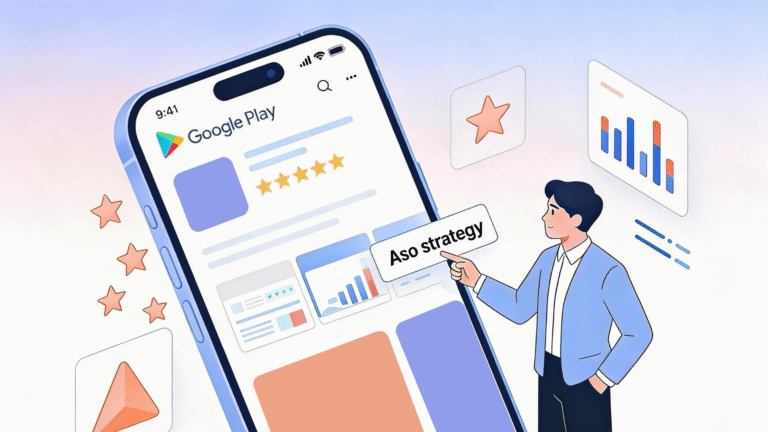To date, Apple Store and Play Market are the largest stores that distribute mobile games and apps. While Amazon and Windows Store try to compete, they are far from these giants regarding user numbers and titles. If you are a mobile developer or publisher, you should clearly understand the difference between App Store vs Google Play. Although the goal of these platforms is the same — to provide customers with access to millions of apps — they still differ in many ways.
The point is not only that the first one offers products for iOS and iPad and the second one — for Android. The differences between these stores lie much deeper, and you need to know them not only for developing apps but also for their successful promotion. In this article, we will look at the nuances of how each platform works, both in terms of development and ASO strategy. After reading, you will know the features of the algorithms and user behavior on them and be able to use them effectively in your development.
Table of Contents
App Store vs. Google Play: Main App Store Comparison
If you dig deeper, the difference between Google Play vs Apple Store will be huge. In fact, only one thing connects them — they host games and apps that users can install on their portable devices. — Asolytics Team
- Development
Different languages and programming tools are used to create such products. How does Google Android software differ from that of Apple? The first is a partially open-source model based on Linux, which is highly customizable and can be installed on various devices. The second has a closed, practically non-customizable model (unless jailbroken), which only works on Apple devices. At the same time, an Apple unified design is considered more user-friendly.
- Approval
The Play Market and App Store review process is different. While it takes about two hours to approve an app’s placement in Google Play, it takes nearly two days for the App Store. You can make changes to Android products and page assets whenever you feel like it. With iOS apps, it takes longer. In general, it is believed that the Play Market has a higher approval threshold than the App Store, so it’s easier to publish on the former.
- Revenue
Developers of products available on the App Store vs Google Play are required to give 15% and 30% of their income to the platforms, depending on the sum. The only difference between them is how the increased fee is calculated. We considered this issue in more detail in our article “Google Play Store and Apple App Store Fees.” That is, both marketplaces’ earnings directly depend on developers’ income.
- Number of apps
Traditionally, the store for Android devices leads in the number of published apps. Now, you can find over 3.95 million titles there. There are significantly fewer products in Apple Store, about 1.6 million. You can imagine that the competition is still really huge.

Where Are the More Active Users – App Store vs Google Play?
Statistics show that Android device users are, on average, 40% more determined and active than owners of Apple gadgets. — Asolytics Team
Experts attribute it to the fact that app pages on Play Market have more catchy and well-structured templates. Everything you need to make a decision (including visual elements) is provided at the top of the page. So visitors do not have to rack their brains to find the answer to “What does the Play Store app look like?”
On App Store, you often need to scroll through screenshots and expand descriptions to conduct a comprehensive review of a product. Android developers can use this user audience’s feature to their advantage by making those assets visitors see first as creative as possible. In the article “Android vs. iOS User Behavior,” we took a closer look at the difference between audience behavior.
Differences in ASO Strategy
Now, we come to the most crucial question. The differences in app development for various platforms are obvious. However, not everyone knows the difference between the App Store and Play Market algorithms and fully understands their impact on the visibility and discoverability of their product.
Google Play Store
Although Android users can find apps from any app store besides Google Play, this marketplace is still the leader in downloading mobile games and apps.
In terms of ASO, the Android store’s algorithms are more advanced than those of App Store. — Asolytics Team
Although none of the marketplaces publicly disclose their tools’ features, experts believe that Play Market can even analyze text in screenshots. Diverse assets have different weights, but together, they can improve your search rankings.
Among the page assets that have the most weight and need proper optimization are the following:
- title;
- short description;
- long description;
- reviews and replies.
These elements should contain relevant keywords so that search algorithms can rank them in the best way for you. At the same time, algorithms can scan literally any information on the page. As we have said, the Google Play review process is much simpler, so you can tweak your app page anytime.
Working with user reviews is an important aspect of optimizing a product for Play Market. In addition to giving hints on how to improve your item, they are also a great tool for influencing the algorithms. You can include relevant keywords based on ASO intelligence in your responses as they also rank. You should not forget that your answers have to be valuable.
When developing an ASO strategy, you also need to remember that Google Play has a more advanced app categorization system than App Store. This platform has over 30 categories, and you can assign up to five additional tags to help users find you faster.
Apple App Store
Although experts agree that the App Store algorithms are less advanced than Google Play, this platform has its own features that help developers reach their target audience faster. — Asolytics Team
Among the page assets that have the most weight in this store are the following:
- title;
- subtitle;
- keyword field.
These three elements are indexed and affect the position of your product in the SERPs. The algorithms of Apple Store compare and analyze user requests and keywords that developers have manually added to the listed assets. All other information on the page is presented solely for visitors’ information and is necessary to create a good first impression.
It is believed that the App Store moderators are more active in selecting products for various collections (like trending categories and editors’ choices) and, accordingly, promote them better than Play Market. Developers also have the opportunity to increase their presence on the platform through in-app purchases. Each IAP is displayed separately from the main product in the search results.
Also, when developing an app and ASO strategy, it is worth remembering that, according to app sales statistics, Apple gadget owners are more inclined to use paid products and subscriptions than Android users. App Store is considered to be more secure and reliable. That is why customers are ready to pay, knowing they will receive a safe product.
We’d like to add a few words about the difference between the App Store and the Apple Store because not everyone understands it. The first is a store/marketplace for mobile apps and games from different developers and publishers. The second is a store for gadgets and accessories manufactured by Apple. When it comes to ASO, the first option is meant.
The Most Important Elements in Both Stores for Users to Interact With
The App Store and Google Play icons and titles are essential elements of any product because they are visible everywhere your app is mentioned. However, there are other details that users interact with most often.
- iOS: Screenshot gallery
Statistics show that all Apple device users interact with screenshots in one way or another. They are about twice as likely as Android owners to scroll through the entire gallery to get a closer look at the nuances of the interface. To create engaging screenshots, you need to conduct deep A/B testing.
- Android: Promo video
On this platform, users are, on average, twice as likely to view videos as they are on the App Store. Even though visitors often interact with this element, only 20% of viewers watch it to the end. You need to captivate them from the first seconds. Split testing is also required to get the best out of your product and choose the perfect Google Play Store video format.
- Both stores: Description
The first sentences of descriptions can motivate users to open the full text or even download the app right on the spot. Although the “Read More” button gets 25% more clicks on average on Play Market, it is still frequently interacted with on App Store. From an ASO perspective, the first two-three description lines are incredibly important.
Google Play and Apple Store: Use the Difference to Your Advantage
The debate about which platform is better, the App Store or Play Market, will probably never subside. By and large, it is meaningless because each marketplace has pros and cons that simplify or complicate the work of developers, publishers, and marketers. Fortunately, both stores evolve pretty quickly, regularly introduce new tools, and improve algorithms.
Google Play features:
- fast moderation process;
- you can make changes to page assets at any time;
- huge competition (more than 3.5 titles);
- algorithms analyze all the information on pages;
- there are low-quality products;
- one-time developer fee;
- free and shareware apps are more popular.
App Store features:
- a long process of moderation;
- you can change page assets only together with the update’s launch;
- lower competition;
- you can increase product visibility using IAPs;
- high quality and security;
- annual developer fee;
- higher developer income as users prefer paid products.
You need to know all these features and understand each platform’s nuances to effectively use them to your advantage, regardless of whether you create a native or cross-platform product.
Only you can determine which is better for your task, App Store or Play Market. — Asolytics Team




